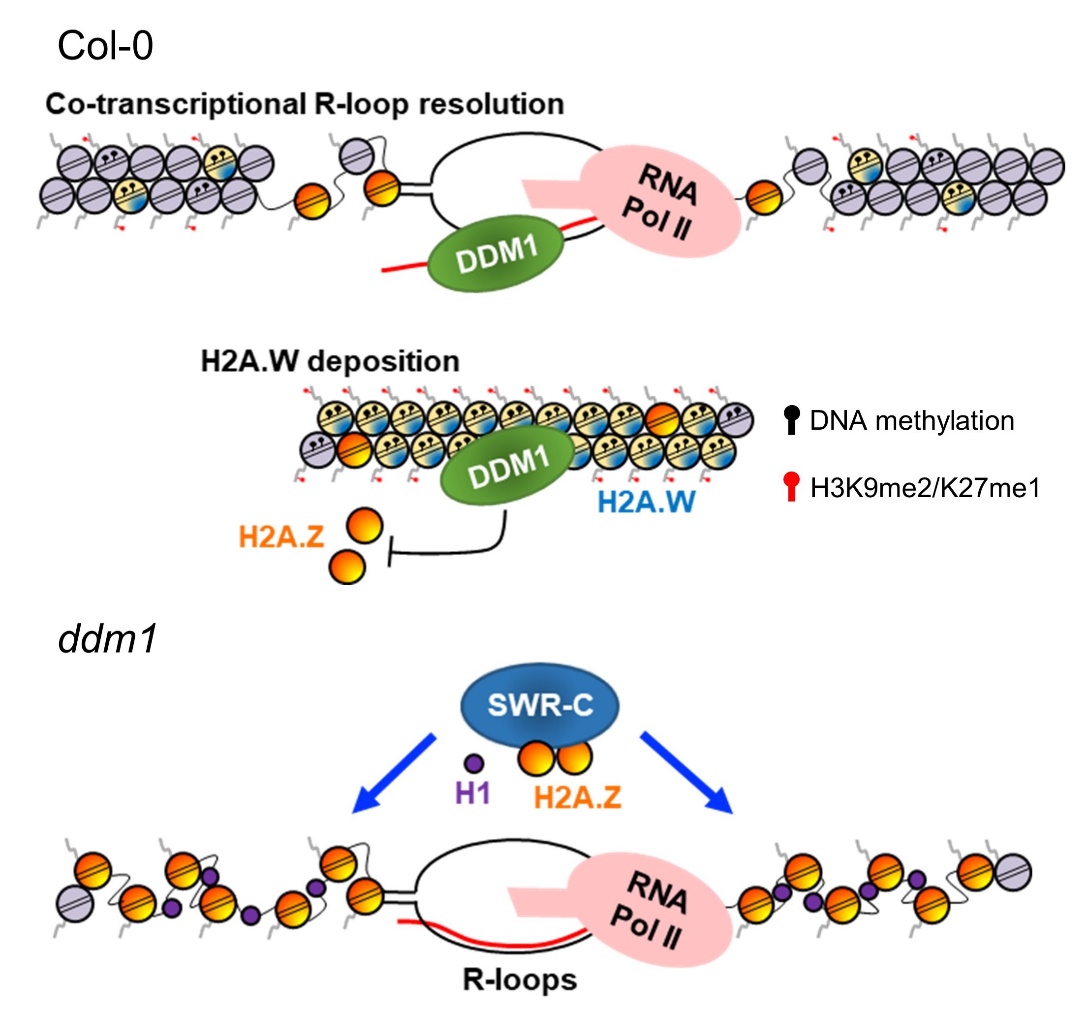Eukaryotic heterochromatin is a highly condensed region that is enriched with various transcriptional repressed epigenetic marks, such as DNA/histone methylation, and specific histone variants. It plays a crucial role in maintaining gene silencing and genome stability. Chromatin remodeling proteins can modulate the interaction between DNA and histone octamers on nucleosomes, thereby altering the compaction level and three-dimensional conformations of chromatin, and affecting gene expression. R-loops are three-stranded nucleic acid structures composed of RNA:DNA hybrids and single-stranded DNA, which are widely present in the genome. Previous studies have detected a large number of low-peak R-loops enriched in the heterochromatic regions of the Arabidopsis genome, but their corresponding functions and biological significance remain unknown.
On August 11th, the research team of Qianwen Sun from the School of Life Sciences at Tsinghua University published their research paper titled "DDM1-mediated R-loop resolution and H2A.Z exclusion facilitates heterochromatin formation in Arabidopsis" in the journal Science Advances. The study revealed the mechanism by which the chromatin remodeling protein DDM1 initiates heterochromatin formation in Arabidopsis via resolving R-loop structures and excluding the histone variant H2A.Z.
DDM1 (decrease in DNA methylation 1) belongs to the SWI/SNF chromatin remodeler. It was discovered in 1993 that mutations in DDM1 lead to a global decrease in DNA methylation levels of the Arabidopsis genome, but the underlying mechanism remains unknown. Through genome-wide R-loop sequencing of numerous mutants that affect the heterochromatin state in Arabidopsis, researchers found that mutations in DDM1 significantly increased the levels of pericentromeric R-loops. Multi-omics analysis was carried out to demonstrate that DDM1 is enriched in the pericentromeric regions of chromosomes and functions in suppressing transcriptional R-loops, thereby ensuring the heterochromatin establishment near the centromeres.
DDM1 contains two domains, an N-terminal SNF2 and a C-terminal helicase region. The ddm1-1 mutant carries a C to Y mutation at the 615th amino acid residue in the C-terminal helicase region. In vitro results showed that RNA:DNA hybrid can significantly stimulate the ATPase activity of the recombinant DDM1 protein, and the DDM1 protein can resolve RNA:DNA hybrid substrate. However, the helicase activity of the mutant protein DDM1C615Y was significantly reduced. Combined with in vivo data, these results suggest that DDM1 can directly remove R-loop structures generated by transient transcription in heterochromatic regions and promote heterochromatin formation.
To further explore the mechanism by which DDM1 promotes heterochromatin formation, the researchers used immunoprecipitation-mass spectrometry analysis to identify interacting proteins of DDM1. The results showed that DDM1 can interact with various H2A histone variants. Further tests demonstrated that DDM1 can interact with both H2A.W-H2B and H2A.Z-H2B dimers, but H2A.W-H2B can inhibit the formation of the DDM1-H2A.Z-H2B complex. This result is also consistent with the phenomenon in the genome that DDM1 helps H2A.W to deposit at pericentromeric regions and inhibits the enrichment of H2A.Z in that region.
Since the deposition of variants H2A.Z on chromosomes is mediated by the SWR1 complex, the researchers knocked out the key factor, ARP6, of the Arabidopsis SWR1 complex in the ddm1 background and found that the ddm1arp6 double mutant can partially reduce the accumulation of H2A.Z compared to ddm1 single mutant, while restoring the elevated R-loop levels and decreased DNA methylation levels in ddm1. These results indicate that DDM1 can inhibit the accumulation of H2A.Z at pericentromeric regions and simultaneously resolve the transcription-coupled R-loops caused by H2A.Z enrichment, thereby promoting heterochromatin formation.
Finally, the researchers found that the functions of DDM1 in inhibiting H2A.Z and resolving R-loops are closely related to the morphology of pollen nuclei. In wild-type pollen, DDM1 is enriched in the sperm nuclei (SN), while H2A.W also accumulates in the sperm nuclei. However, H2A.Z and R-loops are enriched in the vegetative cell nuclei (VN). After the loss of DDM1 function, H2A.Z and R-loop signals can spread into the sperm nuclei, but the aggregation state of H2A.W in the sperm nuclei remains unchanged. Additionally, the abnormal accumulation of H2A.Z and R-loops in the ddm1 mutant is accompanied by the “valley” formation in the sperm nuclei.
In summary, this study reveals that DDM1, a chromatin remodeling protein in Arabidopsis, plays a major role in excluding the accumulation of H2A.Z in heterochromatic regions and resolving R-loops, thus initiating heterochromatin formation. It elucidates a novel molecular mechanism and biological significance of DDM1 in maintaining genomic DNA methylation.

A working model for DDM1 facilitating heterochromatin formation
The corresponding author of this paper is Associate Professor Qianwen Sun from Tsinghua University. The first author of the paper is Dr. Jincong Zhou, a postdoctoral researcher from the School of Life Sciences at Tsinghua University. This work was supported by the National Natural Science Foundation of China, the Ministry of Science and Technology of China, and the Tsinghua-Peking Center for Life Sciences.
Editor:Li Han

